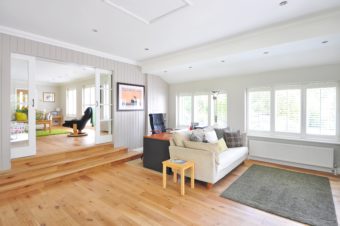August 1, 2022

While hardwood floors do suggest their strength and lasting durability from their name, hardwood floors are not actually, well, hard. Compared to its competitors such as tiles or laminate, hardwood flooring is prone to damage like any other floor type. Wooden floors are naturally prone to scratches, fading or even water damage over time but that does not mean there are no solutions to help salvage your wooden floorboards!
If your floorboards are showing signs pointing to one or more of the floor problems stated above, there are prevention methods and solutions to each one of them!
Firstly, buckled flooring or buckled floorboards refer to the expansion and contraction of your floorboards due to moisture damage. ‘Cupping’ is the term used when your floorboards are turned up at the edges while ‘Crowning’ is the puffed-up area causing a hump to rise in the middle where the damage is.
Solution: For minor buckling, all you would need to do is soak up all the excess moisture using towels and clean the area with a good yet safe disinfectant for your hardwood floors. Once dried, vacuum the area thoroughly to prevent any trapped debris or dust. The crowning should reduce or flatten completely once it is dry. However, if the boards are still showing signs of damage and buckling, you may need to replace your floorboards.
Scratches and marks are completely normal to appear over time on wooden floorboards due to wear and tear over time.
Solution: Minor scratches can be buffed away using fine sandpaper in light, feathery strokes in-line with the wood grain. Scratches on polyurethane finished floors can be repaired using wax sticks or wood stain markers.
Like scratches, gouges and dents are inevitable to avoid with time but are just as easily repaired.
Solution: For deep gouges and dents, wood floor filler is able to repair the area. Start by taping off the damaged area to avoid accidentally filling the wrong areas. Apply the filler using a putty knife and allow the now filled area to dry. Sand it down and it is done!
Yet another unavoidable damage, creaking floorboards can get extremely frustrating.
Solution: Believe it or not, sprinkle baby powder or talcum powder or baking soda into the squeaky board. Work the powder into the seam to lubricate them which prevents the boards from rubbing against each other.
Moisture can cause discolouration on your floorboard surface.
Solution: Using fine steel wool, gently rub the faded spot and apply wax after. Once the wax dries, buff the spot with a clean cloth. As for polyurethane finished flooring, rub the spot with a damp cloth. Stubborn spots can be removed using store-bought cleaners safe for polyurethane floors.
Depending on how badly the hardwood floors have been damaged, there are different solutions to help repair them. Floorboard repairs are relatively simple to do with minimal tools and steps to follow.
Minor scratches can easily be buffed away using steel wool or by sanding them down. Always sand in-line with the wood-grain.
Yes, very much so! It would be easy and economical to make small repairs by only replacing the damaged sections.
Normally, quality wood flooring can last a really long time, some even up to 50 years! Unfortunately, all good things must come to an end and that includes your hardwood floors. In most cases, homeowners would prefer to refinish their floors before considering replacing them. Quality hardwood floors can be sanded down and refinished at least six times to ten times before having to be replaced. Hence, do keep track of the times you have refinished them.
If you have reached your quota and still find it hard to let go of your flooring, here are some reasons and signs to know if it is time to replace your wooden floors:
Yes! Replacing floorboards can be easily done by yourself at home with a few steps. By then, you may wish to consider other forms of wood flooring such as laminate or vinyl planks which can be easily installed by yourself too. Of course, the option to hire professional help will still be available but this could be a great project for our beginner home DIY-ers out there that we would highly recommend you to try. Additionally, you might want to consider dark floorboards as they can easily hide small scratches and dents too or floorboard paint would do just as well.
Knowing how to fix your wooden floors by yourself can be both rewarding and cost-efficient. Albeit it may be tedious but a great skill to acquire by homeowners. However, there are some damages where it is best to get professional consultation and help. Hence, that is where Jupps Flooring comes in! From timber floor repairs to wooden floor repairs to even having to fix stains on your newly polished floorboards, Jupps Flooring experts have never not been able to solve a flooring problem. Drop us an enquiry today and we will show you just how we do it!